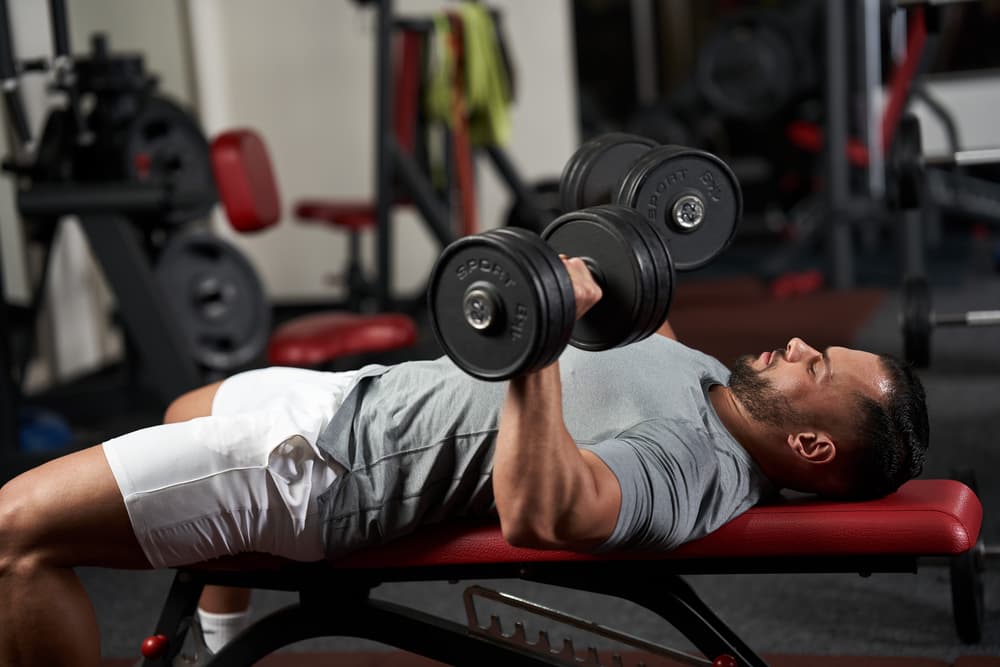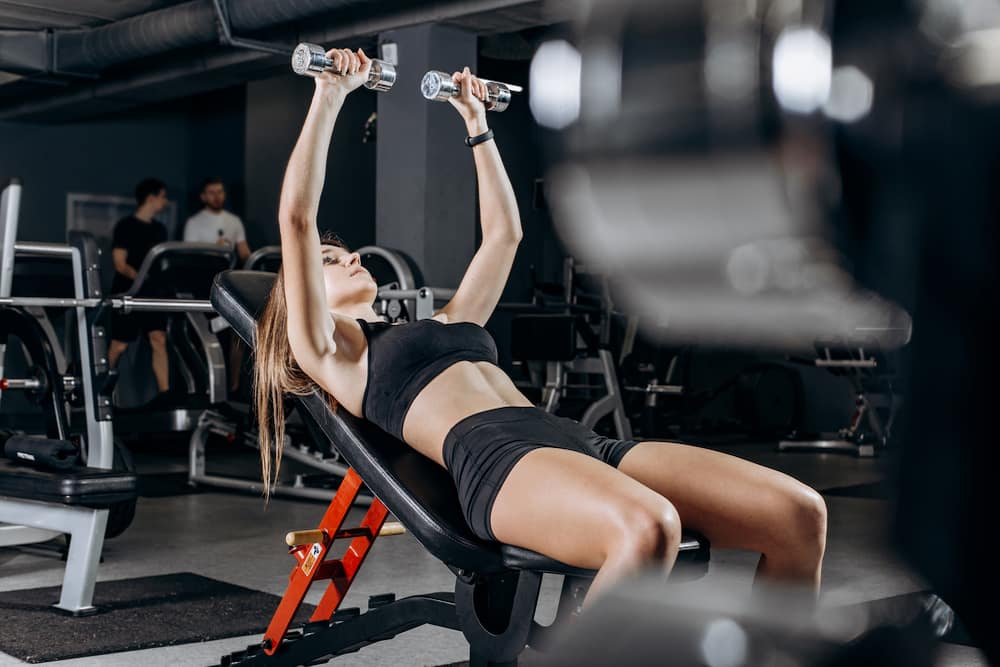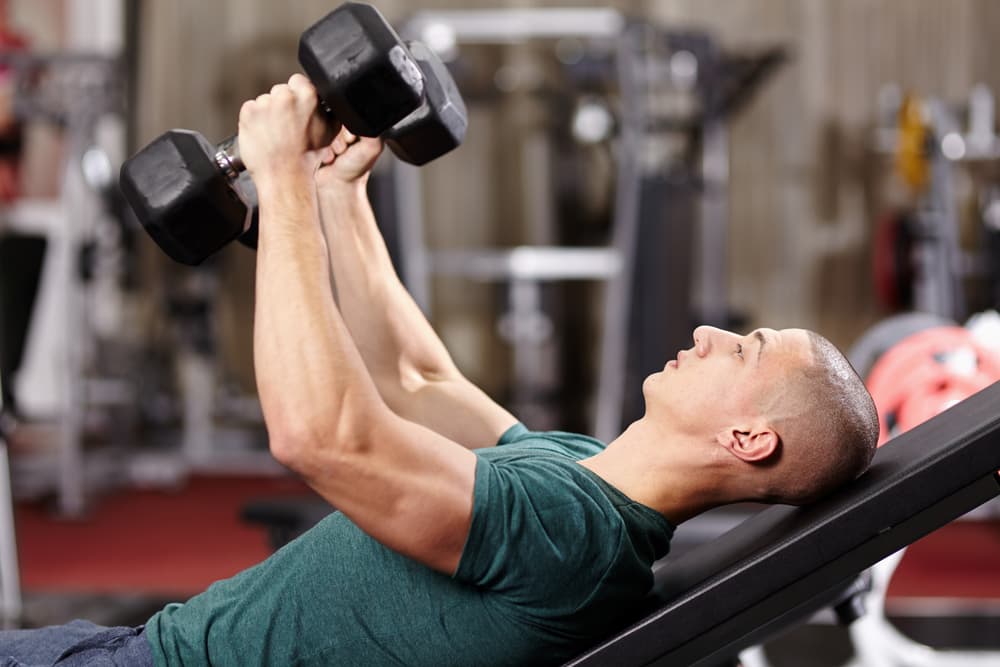Are you looking for ways to work out your pec muscles? If yes, then read on. Let’s build up your chest strength and learn how to do a dumbbell bench press.
Dumbbell Bench Press: Target Muscles
Nope, you don’t have to limit your adjustable weight bench to barbell exercises.
You can always combine it with a pair of dumbbells and work out these muscle groups:
- Pectoralis major. The chest or pectoral muscles exert the most force to execute this move.
- Triceps. These muscles are responsible for extending your elbows every bench press lockout.
- Deltoids. Your shoulder muscles stabilise the joints as you stretch your arms while bench pressing.
Dumbbell Bench Press: Benefits
A standard bench press targets the chest and shoulder muscles. It also involves your lower body to keep your balance and perfect form.
It’s an excellent chest exercise to develop your muscles and push strength. The dumbbell bench press is also a great alternative to the barbell bench press.
Now, if you swap the barbells with dumbbells, you get all these plus the following unique advantages:
- Joint-friendly grip. Lifting a barbell requires a fixed hand and elbow positioning that can cause pain or discomfort. On the other hand, lifters can adjust their grip with a dumbbell, allowing a more natural joint angle.
- Balanced development. Your body tends to rely more on its dominant muscles to perform barbell exercises. With a dumbbell bench press, all muscle groups get equal engagement. Gaining unilateral body strength, in turn, can help you lift heavier weights.
- Better range of motion. When doing a standard bench press, your chest prevents your arms from lowering down further. In contrast, the dumbbell press variation lets you stretch your muscles more, resulting in well-built shoulders.

Dumbbell Bench Press: How to
Here are the steps to do the dumbbell bench press variation safely and with proper form:
- Sit on the bench while holding a medium-weight dumbbell in each hand. Place the dumbbells on your thighs, and keep your feet on the ground.
- Next, grip the dumbbells tight, then slowly lower your upper body down onto the bench, lying face up. At the same time, raise the dumbbells in front of your shoulders. Position them at a 45-degree angle, matching your wrist and elbow.
- Now, lower the weights to about an inch above your chest. Pause for a bit, then slowly drive the dumbbells back up to make one rep. When doing this, make sure not to shift your shoulders forward.
Tips
- Try doing three sets of dumbbell bench press with 5-6 reps to build up strength. Make sure to rest for a few minutes between sets.
- Perform three sets with 8-12 reps each to increase muscle mass. Or boost muscular endurance with three sets of 15-20 reps.
- Inhale when you lower the weights, then forcefully exhale as you raise them.
- Squeeze your shoulder blades together throughout to keep yourself stable on the bench. It should feel as if you’re pinching a pencil in between them.
- Do not strike the dumbbells together at the top. It will only release the tension from your muscles, defeating the purpose of this chest move. Banging the dumbbells can also lead to instability, resulting in a dangerous loss of posture, grip or control.

Dumbbell Bench Press Variations
One thing I like about this bench press movement is its many variations.
These let you zero in on specific muscle groups to meet your bodybuilding goals.
Try one or two of these variations to spice up your bench press training and avoid the weight-training rut!
Incline dumbbell bench press
Target: Upper chest, front shoulders and triceps
Aim: To boost upper body strength and correct imbalances
How-to: Set the incline of your adjustable bench between 30 and 45 degrees. Note that a lower angle targets your upper chest muscles more, while a bigger one hits the shoulders.
- Sit on the incline bench with your feet flat on the ground. Your back should be touching the pad.
- With your palms facing forward, position the weights to chest level.
- Now, exhale and raise the dumbbells with your arms fully extended.
- Hold this for a bit, take a deep breath and slowly return to starting position.
- For more challenging incline presses, switch out your dumbbell with a set of kettlebells.
Decline dumbbell bench press
Target: Lower chest muscle, shoulders and triceps
Aim: To make the chest and ab muscles more defined
How-to: Set the decline bench between 30 and 45 degrees. Note that the greater the decline press angle, the more challenging the exercise. Use the leg brace if needed for security.
- Sit on the top of the slope, then slowly lean back with your dumbbells close to your chest.
- Now, take a deep breath and raise the dumbbells with your arms fully extended.
- Hold this for a bit, inhale and slowly return to starting position.
- Have a spotter when doing this for the first time to keep your correct form in check.

Hammer-grip dumbbell bench press
Target: Chest and triceps
Aim: To condition and strengthen the chest muscles
How-to: You can perform this move on an incline or flat bench. Set the incline angle between 20 and 30 degrees for optimum upper chest development. Note that a higher inclination puts more work on your shoulders and less on your chest.
- Sit down on the edge of your incline or flat bench. Hold and rest the dumbbell on your thighs.
- Push the dumbbells with your thighs as you slowly lie back on the bench. The dumbbells should be straight above your chest, shoulder-width apart.
- Keep your palms facing each other (neutral grip). Then, inhale as you lower the dumbbells down at chest height.
- Now, exhale and bring the dumbbells back up to starting position.
Alternating dumbbell bench press
Target: Chest and triceps, particularly the collarbone (clavicle)
Aim: To isolate each side of the body and even out strength imbalances
How-to: Set your adjustable bench flat. Your form should be the same as when performing standard chest presses.
- With both dumbbells directly over your chest, slowly lower your right arm. The dumbbell should be resting near your arm while your elbow is completely bent.
- Now, exhale and raise the dumbbell back up to starting position.
- Repeat the same move, but use your left arm this time.
- To increase exercise intensity, switch out your bench with a stability ball.
Takeaway
The dumbbell bench press is like the younger brother of the traditional bench press.
It’s the perfect starting point for a beginner lifter who is not comfortable with the barbell bench press just yet.
Try performing this move and its variations twice a week, then level up when you are ready.
Start with lighter weights and keep at it. Soon, you’ll be lifting heavier weights like a pro!
Bench press success starts with a quality adjustable weight bench and pair of dumbbells, though.
Make sure to check my reviews and buying guide to find your ideal exercise equipment.
- Foldable vs Traditional Reformers: Which One’s Right for You? - 2 July 2025
- Elliptical Cross Trainer vs Exercise Bike: Which is Better? - 24 June 2025
- How Do the Different Massage Gun Attachments Work? - 23 June 2025
